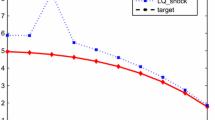Abstract
This paper derives necessary conditions such that cyclical policies may be optimal in concave, two state variable (economic) control problems. These conditions identify four different routes. One major implication is that two of these four conditions may be met by separable models. This possibility has been overlooked so far. Therefore, even separable and structurally very simple models may be characterized by optimal cyclical policies. Indeed, it will be shown that stable limit cycles exist for concave and separable control problems.
Similar content being viewed by others
References
G.S. Becker and K.M. Murphy, A theory of rational addiction, J. Political Econ. 96(1988)675.
W.J. Baumol and J. Benhabib, Chaos: Significance, mechanism, and economic applications, J. Econ. Perspectives 3(1989)77.
E. Dockner, Local stability analysis in optimal control problems with two state variables, in:Optimal Control Theory and Economic Analysis, Vol. 2, ed. G. Feichtinger (North-Holland, Amsterdam, 1985) p. 89.
E. Dockner and G. Feichtinger, On the optimality of limit cycles in dynamic economic systems, J. Econ. (1990), to be published.
G. Feichtinger and R.F. Hartl,Optimale Kontrolle ökonomischer Prozesse (De Gruyter, Berlin, 1986).
G. Feichtinger and G. Sorger, Optimal oscillations in control models: How can constant demand lead to cyclical production?, Oper. Res. Lett. 5(1986)277.
J.M. Grandmont, On endogenous competitive business cycles, Econometrica 53(1985)995.
J. John and P. Holmes,Nonlinear Oscillations, Dynamical Systems, and Bifurcation of Vector Fields (Springer, New York, 1983).
B.D. Hassard, N.D. Kazarinoff and Y.H. Wan,Theory and Application of Hopf Bifurcation, in: London Math. Soc. Lecture Notes 41 (Cambridge University Press, Cambridge, 1981).
Nonlinear economic dynamics, J. Econ. Theory 40(1986)1–195.
Advances in the analysis of economic dynamic systems, J. Econ. Behaviour and Organizations 8(1987)331–530.
H.E. Ryder and G.M. Heal, Optimal growth with intertemporally dependent preferences, Rev. Econ. Studies 21(1973)1.
J.A. Scheinkman, Stability of separable Hamiltonians and investment theory, Rev. Econ. Studies 26(1978)559.
System Dynamics Rev. 4(1988), special issue on chaos.
Author information
Authors and Affiliations
Rights and permissions
About this article
Cite this article
Wirl, F. Cyclical strategies in two-dimensional optimal control models: Necessary conditions and existence. Ann Oper Res 37, 345–356 (1992). https://doi.org/10.1007/BF02071064
Issue Date:
DOI: https://doi.org/10.1007/BF02071064




